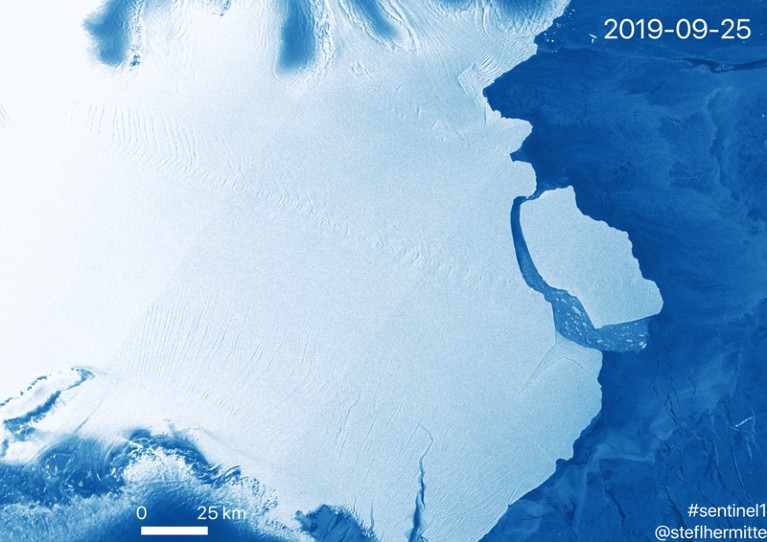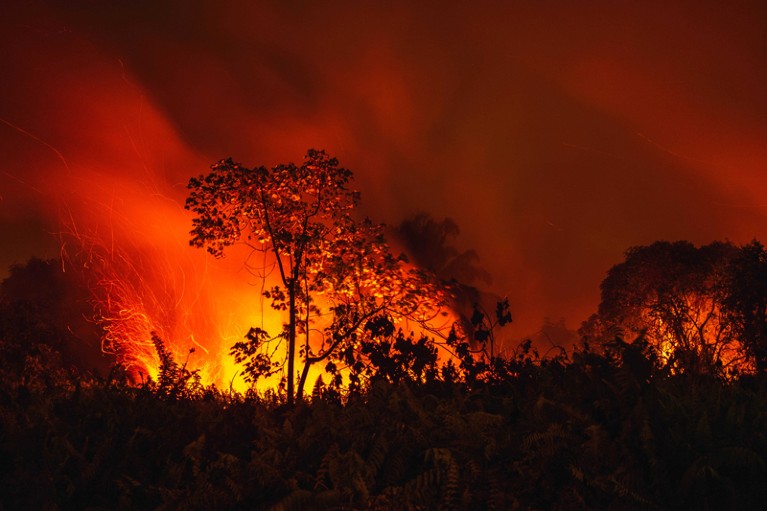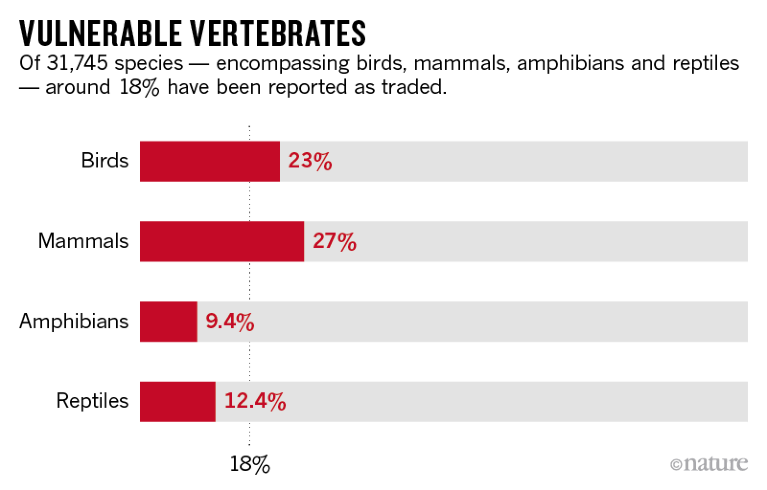CLIMATE
Huge Antarctic iceberg breaks loose An iceberg bigger than Greater London has broken off Antarctica’s third-largest ice shelf. The chunk of ice, which has an area of 1,636 square kilometres and weighs some 315 billion tonnes, came off the Amery Ice Shelf in East Antarctica on 26 September. Surprisingly, the berg, called D-28, broke off just west of an area that scientists had been watching more closely, which is dubbed the Loose Tooth because it looks ready to calve. The event is the latest in a cycle in which big icebergs break off the Amery shelf every six or seven decades. It is not thought to be linked to climate change, although other parts of Antarctica are experiencing rapid ice loss linked to warming. The calving of D-28 might affect how ice moves in this part of the Amery shelf, including the Loose Tooth region.

A satellite image of the D-28 iceberg breaking off the Amery Ice Shelf in East Antarctica. Credit: Copernicus Sentinel-1/Stef Lhermitte
POLICY
Trump vs science US President Donald Trump’s administration has driven government science into a full-blown crisis, according to a report released on 3 October by the Brennan Center for Justice at New York University. The authors, led by former US Attorney Preet Bharara and former Environmental Protection Agency administrator Christine Todd Whitman, say that political manipulation of science has reached unprecedented levels “with almost weekly violations of previously respected safeguards”. They cite the Trump administration’s decisions to disband federal advisory panels, suppress scientific reports and relocate or reassign government scientists, and the White House’s efforts to circumvent Congress by allowing officials who have not been confirmed by the Senate to remain in leadership posts. The report calls for legislation that would establish stronger standards for scientific integrity and encourage the rapid appointment of qualified people to head crucial scientific posts.
FACILITIES
Gravity agreement Japan’s Kamioka Gravitational-Wave Detector (KAGRA) near Hida has joined the international network of observatories that detect gravitational waves. KAGRA officials signed a memorandum of agreement on 4 October to pool data and publish joint results with the Laser Interferometer Gravitational-Wave Observatory (LIGO) in the United States and Virgo near Pisa in Italy; the combined power of the four interferometers (LIGO has two) will enhance the confidence and quality of each detection. KAGRA was completed this year and is due to start its first science run in December; with two 3-kilometre arms stretching through tunnels under a mountain, it is the world’s first interferometer of its size to be built underground. It is also the first to run with cryogenic mirrors, cooled to 20 kelvin.
SPACE
New moons Astronomers have found 20 more moons orbiting Saturn, bringing the known total to 82 — the most in the Solar System. (Jupiter is second with 79.) Saturn’s new-found moons, announced on 7 October, are each about 5 kilometres across. Seventeen of the 20 travel in a direction opposite to the planet’s rotation, suggesting that they are fragments of a larger satellite that broke apart. One of these is the most distant known moon around Saturn. Two of the three other new-found moons travel in orbits that are similar to those of previously discovered moons. The third has an unusual, stretched-out trajectory. The discovery team, led by Scott Sheppard at the Carnegie Institution for Science in Washington DC, has launched a public naming contest. According to International Astronomical Union rules, the moons must be named after giants in Inuit, Norse or Gallic mythology.
EVENTS
Indonesian fires Rains in the past week have helped to extinguish intense wildfires in Indonesian peatlands that have burned for months. The Indonesian National Institute of Aeronautics and Space reported just 179 fire hotspots across the archipelago on 3 October; the previous month, there were 9,310 hotspots in the regions of Sumatra and Kalimantan alone. The Ministry of Environment and Forestry says that 328,000 hectares of forest and peatland burnt across the country between January and mid-September. “Almost 80,000 hectares of the burnings happened in peatlands,” says Nazir Foead, the head of Indonesia’s Peatland Restoration Agency, “and it created a thicker and prolonged haze.” Government climatologists warn that the fires might come back, because the dry season lasts until the end of October.

A fire burns peatland and forest in Pekanbaru, Indonesia.Credit: Afrianto Silalahi/NurPhoto/ZUMA Press
DNA testing A US government plan to routinely collect DNA data from immigrants in federal custody is sparking concerns about privacy and discrimination. The Department of Homeland Security said on 2 October that it was developing regulations that would allow DNA profiles of all immigrant detainees to be stored in an FBI database created to help law-enforcement agencies solve violent crimes. The policy would affect the more than 40,000 people now being held in immigrant detention centres — as well as future detainees. Bioethicists say the efforts will wrongfully target an already vulnerable population. “To me, this is equivalent of a collection from an entire apartment complex where there’s been a murder or where there might be crime,” says Sara Katsanis, a bioethicist at Northwestern University in Chicago, Illinois, who opposes the government’s plan.
FUNDING
Nuclear-fusion plan The United Kingdom has entered the race to build the world’s first prototype commercial nuclear-fusion reactor, with a £200-million (US$270-million) investment announced by the government on 3 October. Over the next four years, the cash will fund the design of the Spherical Tokamak for Energy Production (STEP). In theory, the plant would produce hundreds of megawatts of net electricity from nuclear fusion — the process that powers the Sun — by the early 2040s, demonstrating that the technique is commercially viable. The cost of building the facility would stretch to billions of pounds. “It’s ambitious and adventurous, but I think the fusion programme has to be,” says Howard Wilson, director of the STEP programme at the UK Atomic Energy Authority, which runs the Culham Centre for Fusion Energy near Oxford and is leading the work. Several countries are planning prototype fusion reactors, but no facility has yet sustained a fusion reaction for long enough for it to generate more energy than it takes to run.
AWARDS
Nobel prizes A trio of researchers — William Kaelin, Peter Ratcliffe and Gregg Semenza — won the 2019 Nobel Prize in Physiology or Medicine on 7 October for describing how cells sense and respond to changing oxygen levels by switching genes on and off. Their discoveries, made in the 1990s, have been key in understanding human diseases such as cancer and anaemia. The Nobel physics prize, announced the following day, was awarded to cosmologist James Peebles and astronomers Michel Mayor and Didier Queloz for discoveries about the evolution of the Universe and Earth’s place in it. In 1995, Mayor and his then-student Queloz made the first discovery of an extrasolar planet orbiting a Sun-like star. The field is now one of astronomy’s hottest: more than 4,000 exoplanets have been detected. Peebles’ theoretical work helped to establish the current ‘standard model’ of the evolution of the Universe. Nature went to press before the chemistry prize was announced.
TREND WATCH
Almost one in five vertebrate animals that live on land are traded on wildlife markets — a much greater proportion than previously thought. The findings come from one of the most comprehensive studies of the international wildlife trade yet, involving a survey of 31,745 species of mammal, bird, amphibian and reptile. The authors found the proportion of traded animals to be 40–60% higher than previous estimates had suggested, and predict that it could rise to more than one in four. To identify species that are currently traded, the researchers used databases maintained by the Convention on International Trade in Endangered Species of Wild Fauna and Flora, and the International Union for Conservation of Nature, whose Red List provides the conservation status of most species. They found that 5,579 of the species analysed — around 18% — are being bought and sold around the world. This includes more than 2,000 birds and nearly 1,500 mammals, many captured illegally from the wild, although the figure also includes legal trade. The authors say the findings could help to identify species at risk of extinction, so that policies can be put in place to protect them.

Source: B. R. Scheffers et al. Science 366, 71–76 (2019)



